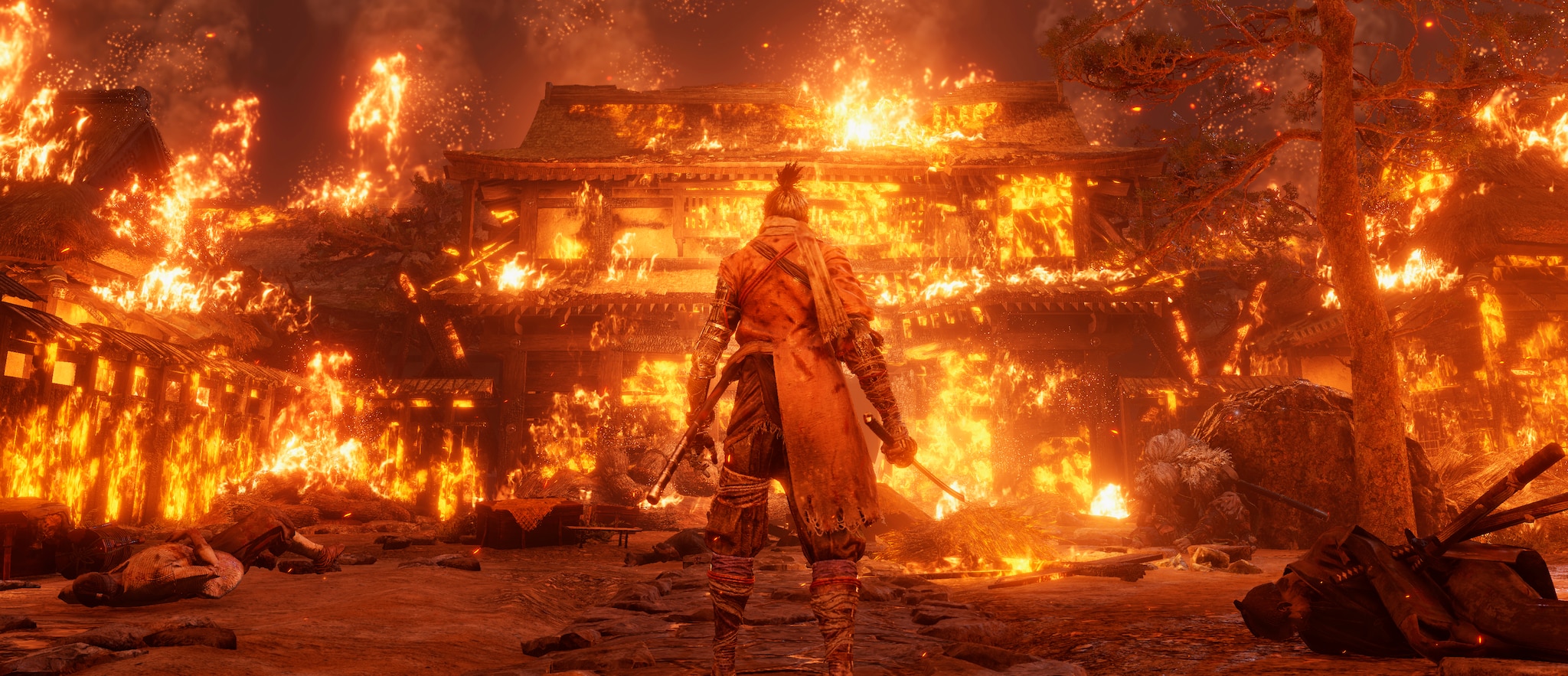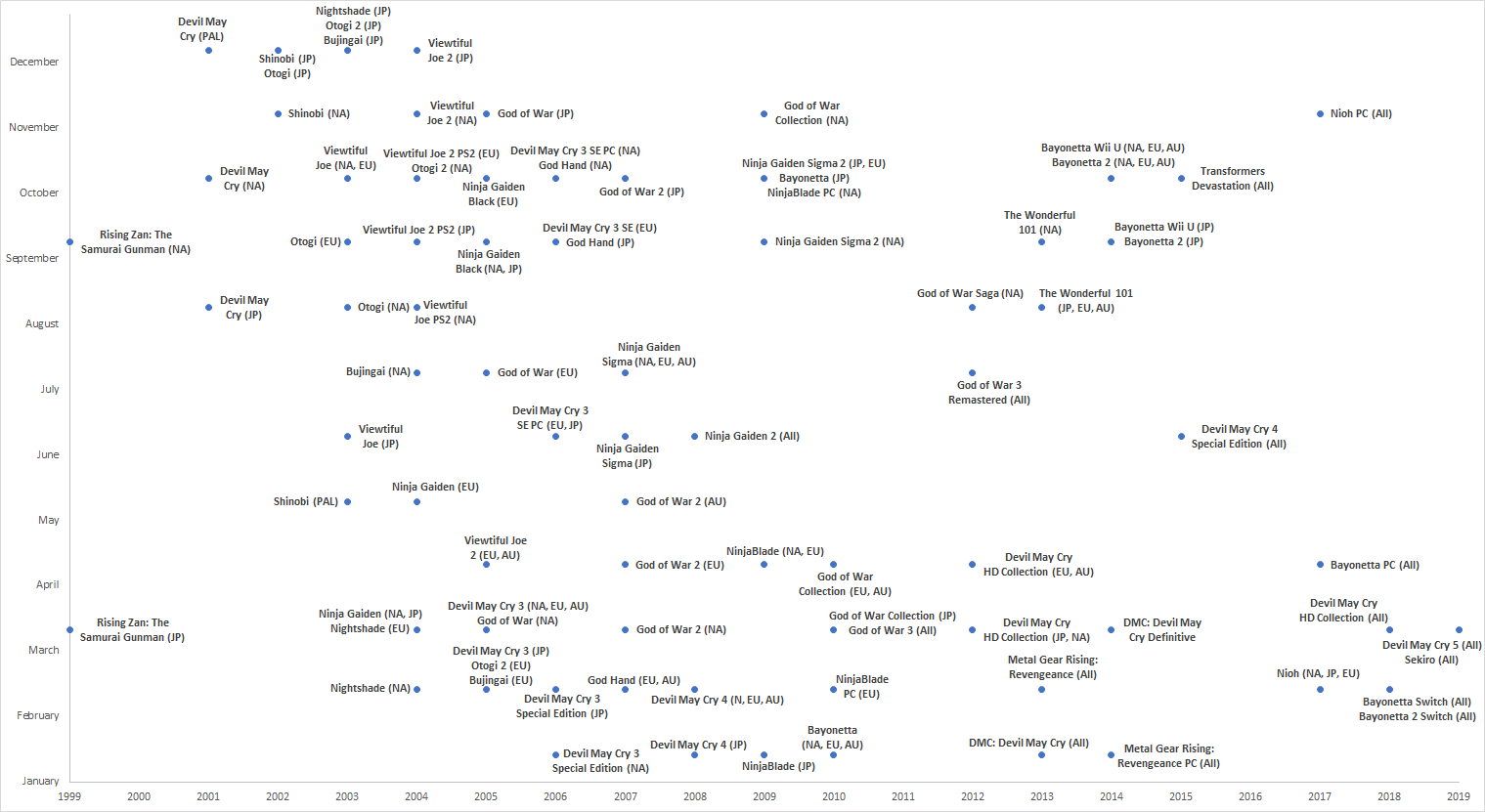March was an unprecedented month for Japanese action games
There's never been a month with two games as good as Sekiro and Devil May Cry 5, and we've got data to back it up.

Devil May Cry 5 came out this month. Not just this year, but 21 freaking days ago. It's a phenomenal character action game, as deep and rewarding to master as it is flat-out ridiculous. Dante dances in a cowboy hat and uses two halves of a demonically possessed motorcycle to beat the shit out of things. It's the best Japanese action game of its type since Platinum's Metal Gear Rising: Revengeance, or Bayonetta, or hell, maybe Shinji Mikami's God Hand, way back in 2006. The point is, if Devil May Cry 5 was the only Japanese action game that came out this month, it'd still be the best month for the genre in years. But then there's Sekiro.
Have two similar games of this magnitude ever come out side-by-side before? Will they ever again?
FromSoftware went ahead and redefined the action genre with a combat system that captures the intimate fury and exhaustion of sword-on-sword combat. Sekiro is a fragile shinobi who has to break down enemies through relentless aggression and exact reflexes. There's no time to hesitate—any brief pause and your opponent can recover and let loose a frenzied retaliation. Swords are always out and always swinging. It's an aggressive inversion of Dark Souls all about making your own opportunities. It's empowering, punishing, and not quite like anything we've played before.
Two tremendous games released exactly two weeks apart. A few days before Sekiro: Shadows Die Twice came out, I started thinking about how crazy it seemed, these two games coming out in the same month. It's like Halo 2 and Half-Life 2 for Japanese action: Two different takes on the genre, for sure—Sekiro isn't a perfect fit for the nebulous "character action" sub-genre, but still has the same focus on skill and precision coursing through its veins. DMC5 asks players what cool shit they can pull off with three unique characters and a dozen weapons, while Sekiro just gives you a plain ol’ katana and says: Master the blade or bust. Have two similar games of this magnitude ever come out side-by-side before? Will they ever again?
It didn't just feel unlikely. It felt unprecedented. Sometimes it's fun to obsess over stats and trivia, so I decided to do some digging.

The question is simple and surprisingly easy to answer, because despite the love and reverence for the likes of Devil May Cry and Bayonetta, there have been precious few of these types of games over the past 20 years. I pored over the release dates for 20 years worth of beloved character action games (most of them on consoles, though newer ones are also on PC) to pinpoint the genre's peak.
It's this month.
March 2019 does have a few good competitors, though. Behold, basically every character action game* on one chart. The X axis is years and the Y axis is months; look for blue dots with multiple game names for months where more than one action game came out at the same time.
Keep up to date with the most important stories and the best deals, as picked by the PC Gamer team.

*(Some games I excluded because popular opinion would clearly disqualify them from "best month ever" contention, e.g. Devil May Cry 2 and Platinum's Legend of Korra. I also excluded games that leaned more heavily into RPG than character action, like Dark Souls and Nier Automata, though I know that last one is borderline.)
Based on these release dates, sourced from Wikipedia, here are some of the best months in gaming history for 3D character action games (and Viewtiful Joe, which are 2D but just felt like they belonged).
December 2003, Japan: This month an incredibly rare three character action games came out at once, but only in Japan. Nightshade, the sequel to Sega's Shinobi reboot, got pretty mediocre reviews at the time. Fast, combo-y combat couldn't make up for bad jumping and bottomless death pits. Bujingai fared better: it was a weird mix of future post-apocalypse, traditional Hong Kong martial arts, and Japanese pop star Gackt. And then there was Otogi 2, made for the Xbox by FromSoftware, a hack-and-slash with a bunch of playable characters. It was quality, and the beginning of From merging action with its RPG roots. This definitely would've been a memorable month if you lived in Japan, but none hit the high bar of all-time-great action games.
March 2005, North America: If there's a single month that can compete with March 2019, I'd argue that it's this one. This is the month Devil May Cry 3 released in North America, followed by God of War three weeks later. God of War is the only non-Japanese character action series on this list, and it made a huge splash at the time. Kratos's blades made for lengthy and brutal combos and the setpieces were epic in a way action games hadn't been before. Action purists would argue all day for the superior depth of Devil May Cry 3's combat, though, and they'd be right—though it was greatly enhanced in the Special Edition released later, and the US version's bafflingly increased difficulty was reigned in.
Still, this was a hell of a month, if you lived in North America.
October 2006, North America: This could have been a stellar month, as it saw the release of Devil May Cry 3 Special Edition on PC and God Hand on the PS2. God Hand is a beloved, brutally hard action game from Shinji Mikami that still needs to get ported to PC, dammit. Unfortunately, DMC3's first PC port was as bad as most Japanese PC games of that era, thus souring October's chances. Besides, DMC3 SE had already hit consoles months earlier.
October 2009, Japan: A big month for quantity, but spread across regions. The Sigma port of Ninja Gaiden 2 hit Japan and Europe, Bayonetta came out in Japan, and FromSoftware's QTE-heavy Sekiro predecessor NinjaBlade released on PC in America. You could call this a high water mark for Japan, because Bayonetta was the successor to Devil May Cry fans had now been waiting several years for, and it was going up against the PS3 version of Ninja Gaiden 2, which likely put it in front of a much larger Japanese audience. It's largely considered an inferior version, though it's significant to me that this is the only time that the DMC/Bayonetta style of action and the Ninja Gaiden style went directly head-to-head.
March 2019, Worldwide: This is the month. Looking back across these other banner months, there are few games being released simultaneously that will stand the test of time like Sekiro and DMC5. April 2005 is the only one that comes close, and this month has one big advantage: universality. In past years staggered international release dates meant games rarely ever landed for everyone at the same time. And it was really the Special Edition release of Devil May Cry 3 that cemented it as the king of the genre for years.
But this month, Sekiro and DMC5 launched worldwide, and it feels safe to say people will be talking about them, and playing them (or re-releases) a decade from now. So, sure, they're great games. But I think there's a bit more to it than that. The words I keep coming back to are luxury and confidence.
Luxury, because Devil May Cry 5 feels like a game overflowing with ideas an energy. Three playable characters with totally different styles, all weaved into one campaign, all with unlockable movesets that you'll barely start mastering in a single playthrough. Luxury, because this game's characters look incredible, and unnecessarily lavish cutscenes were a key tenet for its designers in making the whole ride feel like a ridiculous movie. Confidence, because DMC5 is far smoother and more approachable than older games in the series, but the depth is still there for anyone who can dig it out.
Confidence, because FromSoftware built a towering reputation on the style of combat and arcane RPG features in its Souls games, and then at the height of that fame, made a pure action game. Elements of the Souls games linger, now codified in From's DNA, but Sekiro demands you play it more like the hyper-aggressive Ninja Gaiden 2, unlearning a decade of skills built up on its preceding games. Luxury, because just a few years ago both of these games would've been console exclusives, but they arrived day-and-date on PC with quality ports.
March 2019: Pretty damn good month.

Wes has been covering games and hardware for more than 10 years, first at tech sites like The Wirecutter and Tested before joining the PC Gamer team in 2014. Wes plays a little bit of everything, but he'll always jump at the chance to cover emulation and Japanese games.
When he's not obsessively optimizing and re-optimizing a tangle of conveyor belts in Satisfactory (it's really becoming a problem), he's probably playing a 20-year-old Final Fantasy or some opaque ASCII roguelike. With a focus on writing and editing features, he seeks out personal stories and in-depth histories from the corners of PC gaming and its niche communities. 50% pizza by volume (deep dish, to be specific).

